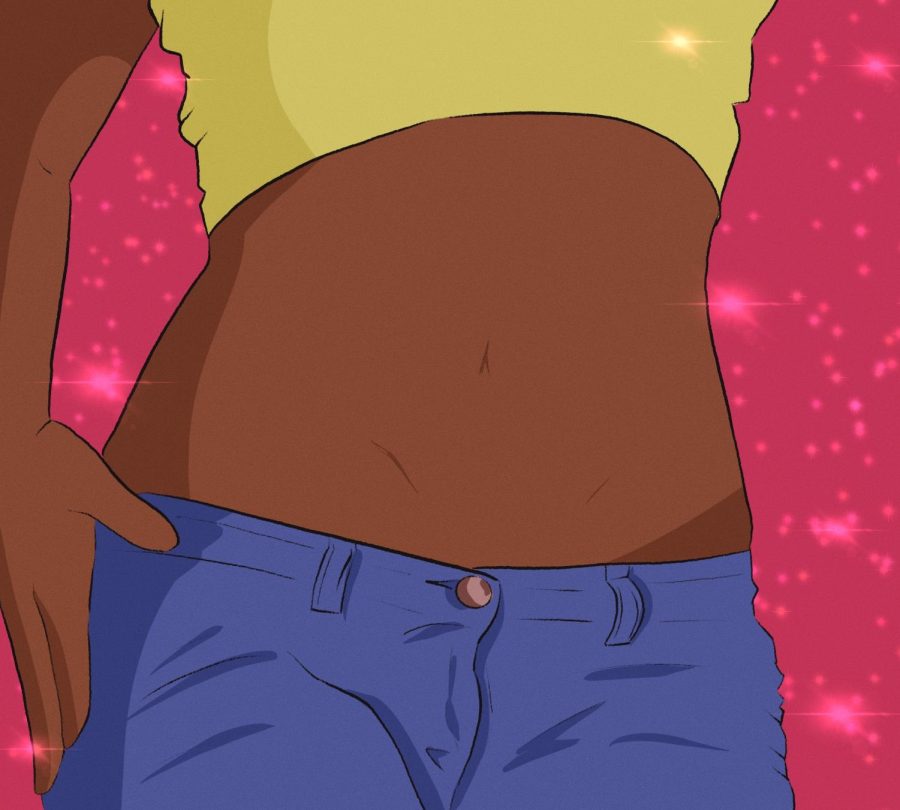OPINION: Keep modern values while wearing old styles
Early 2000s trends on the rise; do not lose progress made in body inclusivity and sustainability
The return of low-rise jeans seems inevitable as other signature Y2K styles explode in popularity.
February 1, 2022
“Oops! I did it again,” the iconic Britney Spears says, as she wears a cropped top, choker and most importantly: her low-rise jeans.
It is almost as if she predicted the future with this song title because her iconic low-rise staple is indeed making a comeback. This trend shaped the childhoods of current college students, but it should be left in the past with jeggings and popcorn tops.
Britney Spears was not the only one to take this trend head-on; Jennifer Lopez at the Video Music Awards in 2000 and Hillary Duff as Lizzie McGuire in 2004 brought a new level of popularity to this denim style.
More recently, supermodels Kendall Jenner and Gigi Hadid have both been seen wearing this style around the streets of Los Angeles.
This early-2000s staple is definitely on the rise for the next few rounds of fashion trends, but the controversy that accompanies these pants has the potential to raise some eyebrows.
The root of the issue that surrounds these pants is the way it fits on women’s bodies – or more accurately, the way the pop-culture world thinks they should fit.
At the peak of their glory, they were worn by extremely thin influencers only – which is why many of us, myself included, are hesitant to participate in this trend.
For whatever reason, women’s body types tend to be as much a beauty trend as makeup or clothing.
Women often feel the pressure to participate in extreme dieting to meet toxic cultural standards. In the early 2000s, ultra-skinny was the expectation, and disordered eating was rampant.
But there is no reason that women’s bodies should change to fit any trend.
As Y2K trends return, so too does the possibility that these unrealistic beauty standards will as well. That is, frankly, unacceptable.
However, our generation has made a great effort to implement body inclusivity into our culture. Even though I still do not love this trend, I hope this inclusive effort will drive women to wear this trend if they feel comfortable, regardless of their body type.
This specific denim trend brings back some dark memories from my middle school fashion choices, but since fashion trends tend to come back in a more upscale version than their original style, I could try to give them a chance.
Low-rise is not the only Y2K style trend making a comeback. On TikTok, the Y2K aesthetic of baby tees and trucker hats have also exploded in popularity.
“Since some of the popular Y2K trends have come back through thrift shopping, low-rise jeans will probably be back sooner than later,” said freshman apparel, merchandising, design and textile major Bailey Wolf.
Our generation has made it very clear that thrifting, which is the most sustainable way to shop, is cool again (which it totally is). Sustainability should always be a factor when deciding which pieces should be added to someone’s wardrobe.
Thrifting allows room to join in on a trend without any new production necessary. New production is particularly wasteful when it comes to fads, as they usually do not stick around very long.
Thrifting is a much better way to keep an updated wardrobe than contributing to the fast fashion industry. Fast fashion companies like Shein and Romwe prey on young consumers by giving them the opportunity to feel included in trends, at an alarmingly cheap price.
“All it takes is a major designer to present [new trends] on the runway at fashion week, and a week later Zara and other fast fashion stores will have it in their stores,” said Fashion Institute of Technology alum Spencer Yeats.
Affordability plays a huge role when young people start building their wardrobe, which is why it can seem too good to be true when a piece that is identical to an Instagram influencer’s can be purchased for less than $10.
It actually is too good to be true.
Mountains of these leftover clothing items build up in landfills once trends die, resulting in extreme environmental damage, according to Middle Eastern news site Aljazeera.
Fast fashion companies also exploit child labor in their production methods, which is how they are able to sell their products at such ridiculously cheap prices.
I will admit that I have been guilty of consuming fast fashion, as a college student with a fairly low budget and a drive to keep up with pop culture.
While on campus, many of us resort to the sweats-and-sweatshirt combination when walking to class. But as soon as the clock strikes 10 p.m., the party tops make their debut.
For college students, having cheap clothes that can get ruined without a huge financial risk is majorly appealing.
Party attire is form-fitting, and usually on the smaller side in terms of body coverage, so I would not be surprised if low-rise pants make an appearance on the Greek Row before I graduate.
It is clear that the newest trends, low-rise jeans included, will be competing for consumption in both thrift stores as well as fast-fashion websites, it is up to the shopper to decide which way to consume this trend.
We have come very far in terms of body inclusivity and sustainability since the early 2000s, and I hope that we maintain our modern values as we wear styles from the past.
Since low-rise did not make an appearance at the Spring and Summer 2022 fashion shows during New York Fashion Week we are probably safe for at least a year, but I would not be surprised if they “Hit me baby one more time.”










